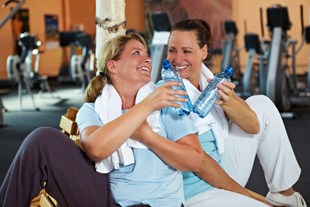What are Osteoporosis and Osteopenia, and What Can I Do to Prevent It?
Your bones are in a state of constant regeneration.
Old, damaged bone is reabsorbed by the body, and newer, stronger bone is deposited to fortify the existing structure. Without this regenerative process, the skeletal system would break down under the wear and tear of daily life.
Bone loss occurs naturally as a consequence of aging. As you grow older, bone is broken down more quickly than it is regenerated, causing the skeletal system to become brittle.
Some bone loss is expected with age, and therein exists what is considered to be a normal rate of bone loss. When bone loss exceeds the normal, expected rates, osteopenia and osteoporosis occur.
Osteopenia occurs when bone mineral density (commonly referred to as BMD) is lower than average peak BMD, but has not yet fallen low enough to be considered osteoporotic. However, those with osteopenia stand a greater risk of becoming osteoporotic as their bone density continues to decrease.
Osteoporosis, on the other hand, is more severe, and is diagnosed in those whose BMD is significantly lower than average peak BMD. Osteoporosis occurs when bone is broken down at an even higher rate, resulting in porous, brittle bones that are susceptible to fracture. Women are particularly vulnerable to osteoporosis due to the natural decline in oestrogen that occurs during menopause. As oestrogen levels decrease, the rate of bone loss tends to increase.
These conditions can occur due to a variety of factors, although age and lifestyle choices such as diet and exercise play the largest role in the progression of the disease.
How Does Exercise Work?
Fortunately, like muscle, bones are capable of becoming stronger in response to exercise.
Exercise works to promote bone health by preventing the loss of bone mass, as well as strengthening the surrounding muscles, tendons, and ligaments that work to support the joint. Exercise also helps to prevent fracture causing falls by increasing balance and proprioception, or your awareness of your body in relation to space.
When muscles are stimulated by activity, they pull on the bone, creating tension and triggering the activity of osteoblasts, specialized cells that help to build new bone. By increasing physical activity, osteoblasts (bone cells) in turn work more expediently to generate a newer, stronger structure.
After reaching the age of 30, bone mass begins to decline due to lifestyle factors such as inactivity, and physiological factors such as hormonal fluctuations. As such, it is particularly important to continue exercising throughout the aging process.
How Do I Make Sure it’s Safe?
If you have a personal or family history of osteoporosis, you may fear that exercise will increase your risk of fall, fracture, or other injury: these are common concerns that can be overcome with proper safety precautions, a personalized routine and gradual adaptation to exercise.
Physicians and physical therapists can offer valuable insight as to specific exercises that may be beneficial or aggravating to your unique situation. If you have any concern over the appropriate activities for your current medical condition, always consult a doctor.
Although certain activities may be off limits due to a current/previous injury or osteoporotic state, most people are still advised to partake in some form of physical activity to help prevent further bone loss.
What Types of Exercise Are Most Beneficial?
Weight bearing activities are particularly beneficial to bone health. The National Osteoporosis Foundation recommends a minimum of 30 minutes of weight bearing exercise each day to promote optimal skeletal health.
In a controlled trial, women with osteopenia who performed weight-bearing exercises for 170 minutes per week experienced a significant increase in bone mineral density (BMD) at the lumbar spine after 14 months when compared to a control group, who performed no such routine and experienced further decrease in BMD.
Weight bearing exercises are those that require you to move against gravity while upright, such as walking, jogging, dancing, low-impact aerobics, or using an elliptical machine.
To get started, gradually increase your current activity level by injecting more physical activity throughout your everyday life.
Suitable activities for beginners include:
- Walking- Partake in a daily walk with friend, family member, or pet.
- Dancing- At home or in a studio/gym/community setting/
- Fitness DVDs- Low intensity/low impact are most suitable for beginners. Many options are available free online or through local libraries.
- Fitness classes- Offered at gyms and community centres, offer instruction in a social, group setting.
Remember to begin with short duration, gradually increasing time, intensity, and the number of days as you adapt to your new regimen. Always consult a doctor before increasing activity level or attempting a new physical pursuit.
References
- Exercise for Strong Bones.” National Osteoporosis Foundation. N.p., n.d. Web. 06 Jan. 2013.
- Kemmler, Wolfgang, Simon Von Stengel, J??Rgen Weineck, Dirk Lauber, Willi Kalender, and Klaus Engelke. “Exercise Effects on Menopausal Risk Factors of Early Postmenopausal Women: 3-yr Erlangen Fitness Osteoporosis Prevention Study Results.” Medicine & Science in Sports & Exercise 37.2 (2005): 194-203. Print.
- Smith, R. “Exercise and Osteoporosis.” Bmj, Postgraduate Medical Journal 290.6476 (1985): 1163-164. Print.
Last Reviewed 11/Mar/2014






